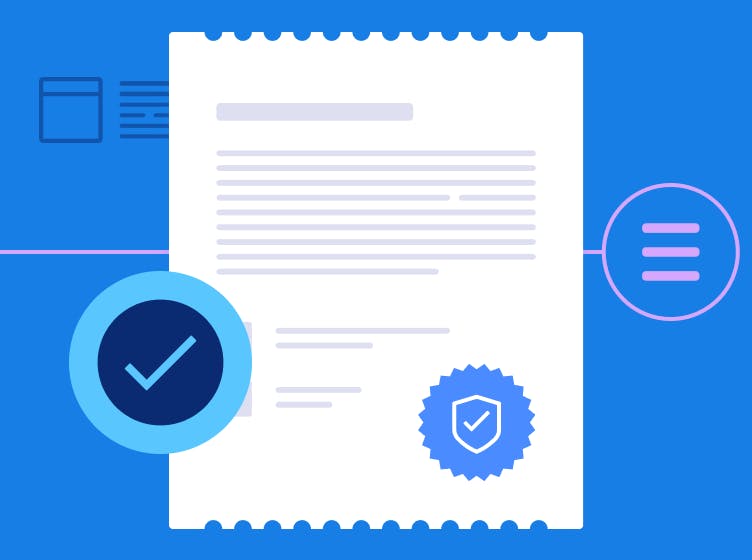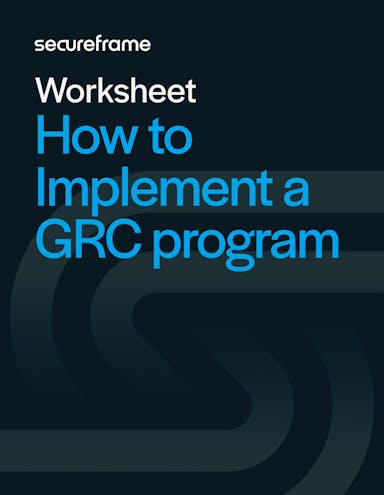A GRC program can help streamline processes, enhance decision-making, reduce duplication of efforts, and provide a comprehensive view of your organization's risk and compliance posture.
But to leverage these benefits, you’ll need to implement an effective program. Find tips and a checklist below to help guide you.
What is a GRC program?
A GRC program integrates the three components of governance, risk, and compliance to provide a holistic approach to establishing effective governance practices, managing risks, and ensuring compliance with regulations and laws.
It encompasses all the people, processes, technologies, and data needed to carry out the following activities:
- Governance: defining roles and responsibilities, establishing decision-making processes, and aligning business objectives with the organization's mission, vision, and values to ensure performance, accountability, transparency, and ethical behavior
- Risk management: identifying risks, performing risk assessments, and developing and implementing risk mitigation strategies to ensure risk is kept at acceptable levels
- Compliance: establishing policies and procedures, conducting internal audits, monitoring controls and taking corrective actions to address any non-compliance issues to ensure ongoing compliance with legal and regulatory requirements
Recommended Reading

Regulatory Compliance: Benefits and Best Practices to Keep Your Business Safe [+ Checklist]
Read MoreTips for building a centralized GRC program
Whether you would like to start a GRC program or strengthen your current program, these tips will help you lay the groundwork for an effective, centralized GRC program.

1. Define what matters
All leaders within the organization should come together to define its objectives, what the GRC program will look like, how current processes could be included, and what silos exist. They should also identify the desired outcomes of the GRC program, such as reducing workforce misconduct or complying with additional regulations and frameworks.
Starting with a clear picture of your organization's objectives, processes, silos, and desired outcomes will help guide the design and implementation of the GRC program so that it meets your specific needs.
2. Identify your risks
Next, identify all the types of risk your organization faces, including operational, financial, technological, reputational, strategic, and compliance risk.
You can start by identifying all the regulations, standards, and internal controls your organization manages. Consider not just the well-known regulations and standards like HIPAA and PCI DSS, but also state and local regulations.
You should also identify which risks are the most critical to help you allocate resources and focus your efforts in the next step.
3. Design a plan
Once your organization has a clear picture of the regulations and risks that will shape your GRC program, you can begin to draft a plan for how to handle the risks. This will include processes or decisions around risk remediation, mitigation, acceptance, and resolution.
It may be easier to focus on one of the three components of GRC first (potentially the one that gives your organization the most trouble). In that case, make sure to outline the order and timeline for various GRC initiatives.
At this point, you should also define roles and responsibilities and how success will be measured.
4. Use GRC software
Using GRC software can help automate and streamline GRC processes, like risk assessment, policy management, vulnerability management, audit readiness, and more.
You should pick a solution that aligns with your organization's needs and can scale with you as your GRC program matures over time.
5. Set up monitoring and reporting processes
With GRC software, you can set up monitoring and reporting processes to track the effectiveness of your GRC program over time. You can track key performance indicators (KPIs) and key risk indicators (KRIs) to measure your progress against desired outcomes and identify areas for improvement.
You should also regularly communicate GRC results and findings to senior management and the board, among other stakeholders, to keep them engaged.
6. Create a system for continuous improvement
Consider yearly or biannual audits and reviews of your GRC program to gauge its effectiveness and make adjustments. You may need to adjust this cadence based on emerging risks, regulatory changes, and industry best practices.
GRC implementation checklist
Ready to implement your own GRC strategy? Download this quick reference sheet with step-by-step implementation instructions and a handy list of do’s and don'ts to ensure a successful roll-out.

Free Worksheet: How to Implement a GRC Strategy
Build your own GRC strategy using this reference sheet with step-by-step instructions.
GRC Best Practices
If you’re still feeling overwhelmed by the task of implementing a centralized GRC program, check out best practices from industry experts below.
- Use a business case to justify the need for a GRC strategy: Evaluate the short- and long-term value of a GRC program, including the scope, cost, and operational benefits.
- Get buy-in from executive leadership: The best GRC strategies have the support of the C-suite. Involve leadership within the GRC strategy by assigning roles and responsibilities.
- Prioritize your GRC objectives: Whether you want to reduce fines or improve agility in the face of new regulations, identifying why you need a better GRC strategy will help shape your objectives.
- Start small, focusing on key processes: As mentioned above, a phased approach allows an organization to start small and focus on the most important area. Start with the organization’s highest priorities, then expand the program. This will help show value faster, and garner continued support from stakeholders.
- Train employees on the importance of GRC: Conduct internal training to educate employees on the value and processes of the GRC strategy.
- Look for feedback: Allow for constructive input from all employees during the initial roll-out to improve and adjust.
- Loop IT into your GRC strategy: Be sure to collaborate with your information technology team throughout GRC strategy creation and implementation to ensure you have enabling technologies in place.
- Use GRC tools: GRC tools can help streamline processes and reduce the manual work required to implement and maintain a GRC program.
- Keep an eye on competitors: Benchmark your company against other leaders in your industry to see how yours stacks up. Have you seen leaders in your industry end up in the news for unsavory non-compliance issues? Let those examples serve as a learning opportunity to train your team on how to identify and avoid similar risks. Additionally, encourage your team to attend GRC webinars to learn about the tools and strategies others are using to optimize their GRC strategy.
- Evaluate remote and hybrid work: Mapping out remote work landscapes can help organizations mitigate risks associated with remote user access.
- Adjust your GRC strategy over time: Optimize your GRC strategy over time based on success metrics as well as changing regulations, technologies, and threats.
Challenges of implementing a GRC program
While the benefits of a GRC program are significant, organizations often face challenges before, during, and after implementation. Understanding these obstacles—and how to overcome them—can help you plan more effectively.
1. Resistance to change
Employees and even leadership may be hesitant to adopt new processes, tools, or cultural shifts required for a successful GRC program. Gaining buy-in, promoting collaboration across departments, and providing awareness and training programs are all essential to overcoming change resistance and easing the transition. Demonstrating early wins can also help build trust and improve engagement.
2. Lack of expertise
Many organizations lack internal expertise to design and implement an effective GRC program. Engaging with external experts and consultants or providing employee training to upskill your internal teams can help bridge this gap.
3. Siloed operations
Many organizations struggle with fragmented systems and processes, making it difficult to achieve the integrated approach required for a centralized GRC program. Fostering cross-functional communication and collaboration, using all-in-one GRC tools to consolidate data and processes, and aligning departmental goals with the broader GRC strategy can help break down silos.
4. Resource constraints
Limited budgets, personnel, and time can hinder the implementation of a comprehensive GRC strategy. Prioritize critical areas that offer the highest impact, demonstrate measurable results, and use these successes to advocate for additional resources and support.
Automation can also significantly cut down on the resources and time needed to implement and maintain a GRC program over time.
5. Complex regulatory environment
Keeping up with evolving regulations and ensuring compliance across multiple jurisdictions can be overwhelming, particularly for global organizations. GRC software can reduce this complexity. This type of software typically includes regulatory change management features that streamline the process of monitoring, assessing, and implementing regulatory changes. Look for a tool that offers access to compliance experts and partners that can help your organization stay informed of regulatory updates and remain agile in the face of change.
6. Measurement difficulties
Evaluating your program’s success can be challenging. Define key performance indicators (KPIs) and key risk indicators (KRIs) from the start and regularly review these metrics with stakeholders to track progress and refine strategies over time.
By proactively addressing these challenges, your organization can create a resilient GRC program that drives value while maintaining compliance and mitigating risks.